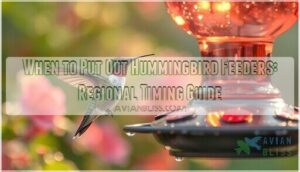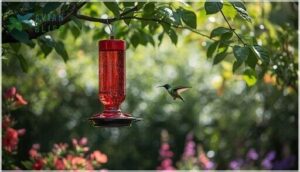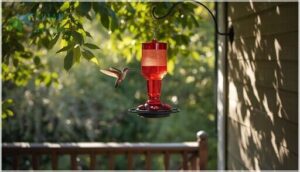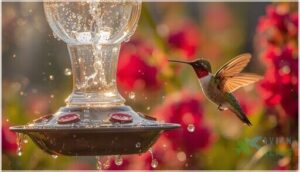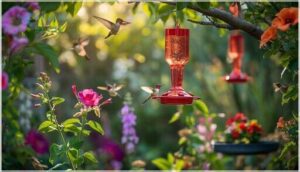This site is supported by our readers. We may earn a commission, at no cost to you, if you purchase through links.
The first ruby-throated hummingbird that arrives at your empty porch won’t stick around to wait for you to notice. These birds burn calories so fast that they need to refuel every 10 to 15 minutes during daylight hours, and if your feeder isn’t ready when they show up, they’ll simply move on to a neighbor’s yard or a patch of early blooms.
Timing matters because hummingbirds follow predictable migration routes, arriving in waves from late February through mid-May depending on where you live. Your location determines when to put out hummingbird feeders—too early and you’re filling feeders for no reason, too late and you’ve missed the scouts that would have remembered your yard as a reliable stop.
Getting your feeder out at the right time helps exhausted travelers refuel during their journey and establishes your space as a regular feeding station for the months ahead.
Table Of Contents
- Key Takeaways
- When Should You Put Out Hummingbird Feeders?
- Regional Hummingbird Feeder Schedules
- Preparing and Placing Your Feeder
- Maintaining Feeders for Hummingbird Health
- Tips for Attracting and Supporting Hummingbirds
- Frequently Asked Questions (FAQs)
- What month should I put my hummingbird feeders out?
- Where should hummingbird feeders be placed in sun or shade?
- Where should you not hang a hummingbird feeder?
- When can I expect hummingbirds in my area?
- How to deter ants from hummingbird feeders?
- What is the best hummingbird feeder material?
- Can hummingbird feeders attract other wildlife?
- How to prevent mold in hummingbird feeders?
- Are there specific feeder designs hummingbirds prefer?
- Do hummingbirds remember feeders from previous years?
- Conclusion
Key Takeaways
- You’ll need to set out hummingbird feeders based on your region’s migration timing—Gulf Coast areas by late February, Midwest and Northeast by early to mid-April, and northern regions by late April to May—because arriving birds burn calories so rapidly they must refuel every 10-15 minutes or move on to other food sources.
- Clean your feeders every 1-3 days depending on temperature (daily above 86°F) using hot water or vinegar solution, as mold and bacteria can grow quickly in sugar water and cause tongue swelling that prevents hummingbirds from feeding.
- Place feeders 10-15 feet from protective cover in partial shade at 4-6 feet height to balance visibility with safety from predators while slowing nectar spoilage, and position them near red tubular flowers that serve as natural markers.
- Mix nectar using only white sugar and water in a 1:4 ratio without red dye or additives, replacing it every 2-4 days in normal weather since artificial ingredients and spoiled nectar harm these tiny birds who depend on your feeder as a reliable fuel station during their long migrations.
When Should You Put Out Hummingbird Feeders?
Timing your hummingbird feeder placement correctly can mean the difference between welcoming early migrants and missing them entirely. The best time to set up feeders depends on where you live and when hummingbirds usually pass through or arrive in your area.
Several factors influence the ideal timing, from migration patterns to regional climate differences.
Key Migration Periods and Arrival Dates
Understanding hummingbird migration patterns helps you time feeders perfectly. Spring bird migration for Ruby-throated hummingbirds begins in late February along the Gulf Coast, with first arrival dates progressing northward through mid-May in Canada. Fall migration reverses this pattern, peaking in early September.
You can consult a hummingbird migration map to see updated sightings. Migration speed factors like weather and food availability affect stopover durations, while regional route variations create distinct migration loop timing across North America.
Regional Timing Across The U.S. And Canada
Hummingbird feeder timing varies dramatically by region. In the Southeast, put feeders out by March 1st, while the Midwest and Northeast wait until early to mid-April. Western states follow mid-to-late April schedules, except desert areas like Arizona, where late March works best. Canada’s first arrivals appear from April 1st onward.
These regional variations reflect migration patterns and resident species distribution across North America’s diverse climates. In central Illinois, it’s recommended to put up feeders between March 21st and April 1st.
Factors That Influence Feeder Timing
Climate change and weather patterns shift when hummingbirds arrive in your area. Rising spring temperatures can push feeder timing earlier by several weeks in some regions.
You’ll also want to watch nectar availability and regional blooms—hummingbirds synchronize feeding with flowering schedules.
Day length and temperature shifts serve as migration cues, though sudden cold snaps can delay arrivals and affect regional hummingbird activity.
Regional Hummingbird Feeder Schedules
Timing is everything for hummingbird feeders, and your location plays a bigger role than you might think. Different regions across North America see hummingbirds arrive at very different times, so you’ll want to have your feeder ready before the first birds show up.
Let’s break down the best timing for your specific area so you don’t miss out on these wonderful visitors.
Southern States and Gulf Coast Guidelines
If you’re along the Gulf Coast or in the Southeast, you’ll want to prepare for early arrival by setting up hummingbird feeders in late February or early March. Spring migration starts sooner here, with males showing up about a week before females.
Climate influence and year-round feeding opportunities mean native plants and feeders work together to support hummingbirds during their journey, so feeding maintenance becomes essential in warm conditions.
Midwest and Northeast Timing
Further north in the Midwest and Northeast, spring migration brings Ruby-throated hummingbirds around mid to late April. You’ll want your feeders ready by early to mid-April to catch those first arrivals, especially the males who show up about a week ahead of females.
- Early feeders support exhausted migrating birds after long journeys
- Males arrive first, scouting territories for breeding season
- Fall removal happens by early October as migration wraps up
- Nectar freshness matters most during warm weather months
Western and Pacific States Recommendations
From the Pacific Northwest down to Arizona, hummingbird feeder timing shifts dramatically with elevation and climate. In California and Oregon, you’ll want feeders ready between mid-February and late April to greet early Rufous and Allen’s arrivals. Migration distances across these states can stretch thousands of miles, so your nectar solutions support essential refueling stops near native flowers.
| Region | Feeder Timing |
|---|---|
| Southern California | Year-round (residents) |
| Pacific Northwest | February–November |
| Arizona | Year-round (Anna’s) |
Year-Round Feeding Regions
Certain regions host resident species that make year-round hummingbird feeding essential for winter survival. Climate influence plays the biggest role in these state-by-state hummingbird guide zones:
- Florida and Texas – Multiple species remain through winter, benefiting from urban feeders and mild conditions.
- Gulf Coast states – Louisiana, Mississippi, and Alabama support wintering habits of Rufous and Ruby-throated hummingbirds.
- Arizona – Anna’s Hummingbirds demonstrate feeding adaptations for desert life.
- California coast – Year-round hummingbird feeding sustains resident Allen’s and Anna’s populations.
Regional hummingbird activity in these areas stays consistent throughout all seasons.
Preparing and Placing Your Feeder
Once you’ve marked your calendar, the next step is making sure your feeder actually works for the birds. Location matters more than you might think—it affects whether hummingbirds will find your feeder, feel safe using it, and return day after day.
Here’s what you need to think about when choosing and setting up the perfect spot.
Choosing The Right Location
You’ll want to find a semishaded spot that balances visibility with protection. Ideal spot for feeders is 10 to 15 feet from cover, avoiding direct sunlight that speeds nectar spoilage. Shade considerations matter most during hot afternoons.
Consider wind and weather—sheltered locations prevent spills and dilution.
Hummingbird feeder placement near nectar proximity sources helps birds find your station, while structure distance from windows reduces collision risk.
Placement Near Flowers and Shelter
Positioning your feeder close to tubular flowers creates an ideal spot for feeders—hummingbirds naturally gravitate toward these visual cues. Flower proximity helps birds discover your station faster, while shelter benefits from nearby trees or shrubs give them safe perching spots between visits.
- Place feeders 10 to 15 feet from cover to balance safety with space visibility
- Use red blooms as natural markers for attracting hummingbirds to your feeder
- Guarantee collision avoidance by keeping feeders away from reflective windows
Height, Shade, and Accessibility
Hang your hummingbird feeders between 4 and 6 feet off the ground—this ideal feeder height keeps them safe from cats while staying easy to reach. Shaded feeder benefits include slower nectar spoilage and cooler conditions that hummingbirds prefer.
Environmental considerations matter for accessibility for birds and human convenience alike.
| Factor | Best Practice |
|---|---|
| Height | 4-6 feet above ground |
| Shade | Partial shade under trees or porches |
| Distance | 10-15 feet from dense cover |
Maintaining Feeders for Hummingbird Health
Keeping your feeder clean isn’t just about looking nice—it’s about keeping hummingbirds safe and healthy. A dirty feeder can grow mold and harmful bacteria that make these tiny birds sick.
Let’s walk through the simple habits that’ll keep your feeder in top shape and your hummingbirds coming back.
Cleaning Frequency and Best Practices
Regular hummingbird feeder cleaning frequency depends on temperature. During hot weather, you’ll need to clean feeders daily to prevent mold growth and nectar spoilage. Temperate conditions allow for cleaning every three days, while cooler weather requires twice-weekly maintenance.
Use hot water or vinegar solutions as cleaning solutions—avoid soap residue.
Watch for cleaning signs like cloudy nectar or visible mold, which pose serious health impacts through fungal infections. Proper hummingbird feeder maintenance ensures mold prevention and protects visiting birds.
Fresh Nectar Preparation and Replacement
After maintaining your feeder properly, you’ll need to focus on the hummingbird nectar recipe itself. Mix one part white sugar with four parts water—this nectar sugar ratio matches natural flower nectar. The right safe sugar types matter: refined white sugar works perfectly, while honey, brown sugar, and artificial sweeteners harm birds.
Your hummingbird food replacement frequency depends on temperature:
- Replace nectar every 2-4 days in normal weather
- Switch to daily changes when temperatures exceed 86°F
- Check for spoilage signs like cloudiness or off odors before each refill
Store extra nectar in your refrigerator for up to two weeks. Proper hummingbird feeder maintenance through fresh nectar keeps your visitors healthy and coming back.
Avoiding Mold and Spoilage
Fresh nectar sets the stage, but keeping feeders spotless prevents the real danger: mold. In hot weather, sugar water turns cloudy and grows mold within just one to two days. This bacterial growth causes tongue swelling in hummingbirds, making feeding impossible. Your cleaning hummingbird feeders routine protects their health.
In hot weather, mold grows in hummingbird feeders within days, causing tongue swelling that prevents birds from feeding
| Temperature | Hummingbird Feeder Cleaning Frequency | Nectar Recipe Lifespan |
|---|---|---|
| Above 86°F | Daily | 1-2 days |
| 70-85°F | Every 2-3 days | 3-4 days |
| Below 70°F | Twice weekly | 4-5 days |
Check for white strings or black spots during hummingbird feeder maintenance—these signal immediate cleaning. Use hot water and a bottle brush, reaching every groove. Bleach solution (1/4 cup per gallon) kills stubborn mold. Feeder placement in shade slows spoilage, supporting hummingbird health and safety year-round.
Tips for Attracting and Supporting Hummingbirds
Getting hummingbirds to visit your yard takes more than just hanging a feeder and hoping for the best. A few simple adjustments can make your space more inviting and help these tiny birds thrive throughout the season.
Let’s look at some practical ways to boost your success and keep hummingbirds coming back.
Using Red Feeders and Decorations
Red feeders work like magnets for hummingbirds—studies show they attract 38% more visits than other colors. You don’t need red dye in your nectar, though. It’s actually risky for hummingbirds and offers no benefits.
Instead, choose feeders with red parts and add red decorations or flowers nearby. This combination makes your feeding station more visible and mimics natural food sources, attracting hummingbirds safely in spring.
Preventing Pests and Predators
To keep pests away, you’ll want ant moats and bee guards on your hummingbird feeder. Regular cleaning prevents sugar buildup that attracts insects.
Physical barriers like pole collars stop squirrels from raiding nectar. Hang feeders away from dense shrubs to reduce predator risks from snakes and mantises.
In bear country, bring feeders inside at night for effective predator prevention and pest control.
Providing Natural Food Sources Nearby
Alongside your feeder, you should plant native flowering plants that match your local hummingbirds’ needs. Natural food sources support healthier birds and reduce feeder dependence.
- Choose red tubular flowers like salvias that bloom during migration periods
- Plant native flowering trees for insects and sap
- Select regional varieties with staggered bloom times
- Create gardens that provide continuous seasonal availability
- Balance feeders with natural gardening for birds approach
Frequently Asked Questions (FAQs)
What month should I put my hummingbird feeders out?
You’ll want to have hummingbird feeders ready in late February through May, depending on regional arrival dates and hummingbird migration patterns.
Springtime timing shifts with weather influence, bloom timing, and species variation across different areas.
Where should hummingbird feeders be placed in sun or shade?
Ideal placement requires balancing contradiction: your hummingbird feeder needs sunlight exposure for feeder visibility, yet direct sunlight accelerates nectar fermentation.
Choose partial shade with morning sun—this protects nectar quality while maintaining predator avoidance through strategic positioning near shelter.
Where should you not hang a hummingbird feeder?
You shouldn’t hang a hummingbird feeder too close to windows due to window collision risk, in direct sunlight that causes nectar to spoil, near heavy human activity, or in windy locations without nearby cover.
When can I expect hummingbirds in my area?
Hummingbirds generally arrive in southern states by late February, reaching the Midwest and Northeast in mid-April, and northern areas by late April to May.
Regional variations are influenced by weather and food sources.
How to deter ants from hummingbird feeders?
Ironically, ants love the sweet nectar as much as hummingbirds. You can use ant moats, physical barriers, natural repellents, and strategic feeder placement alongside regular feeder hygiene to keep these pests away effectively.
What is the best hummingbird feeder material?
Glass feeders offer better safety and cleaning ease due to their non-porous surface, while plastic feeders provide cost-effective durability. Both attract hummingbirds equally well when designed with red feeding ports.
Can hummingbird feeders attract other wildlife?
Yes, feeders can attract bears, raccoons, squirrels, insects like ants and wasps, and other bird species including orioles and woodpeckers.
Proper placement and ant moats help minimize unwanted visitors while supporting hummingbirds.
How to prevent mold in hummingbird feeders?
To stop mold, clean your feeder every 1–2 days using hot water and Dawn dish soap. Place it in shade, replace nectar frequently, and choose dishwasher-safe materials for easier maintenance.
Are there specific feeder designs hummingbirds prefer?
Hummingbirds prefer feeders with red color preference and flower-shaped port design. Material choice matters—glass retains freshness better. Bee guards reduce insect competition, while cleaning ease ensures health. These features boost attracting hummingbirds in spring success rates considerably.
Do hummingbirds remember feeders from previous years?
These tiny birds rely on spatial memory and episodic memory to return to reliable feeders year after year.
Feeder fidelity and nectar consistency encourage migration returns, making hummingbirds excellent at remembering productive food sources.
Conclusion
Patient preparation pays off when you learn when to put out hummingbird feeders for your region. These tiny migrants depend on reliable fuel stations during their long journeys, and your early action transforms your yard into a lifesaving rest stop.
Keep feeders clean, nectar fresh, and placement thoughtful throughout the season. The reward isn’t just watching iridescent wings blur past your window—it’s knowing you’ve helped sustain one of nature’s most extraordinary travelers through another successful migration cycle.
- https://www.southernliving.com/when-to-put-out-hummingbird-feeders-8584598
- https://www.audubon.org/magazine/hummingbird-feeding-faqs
- https://thehummingbirdfeeder.com/when-to-put-out-hummingbird-feeders/
- https://hcsummers.com/blog/86260/hummingbird-migration-schedule
- https://www.reddit.com/r/orangecounty/comments/1gi4z41/oc_hummingbird_feeding_practices/

